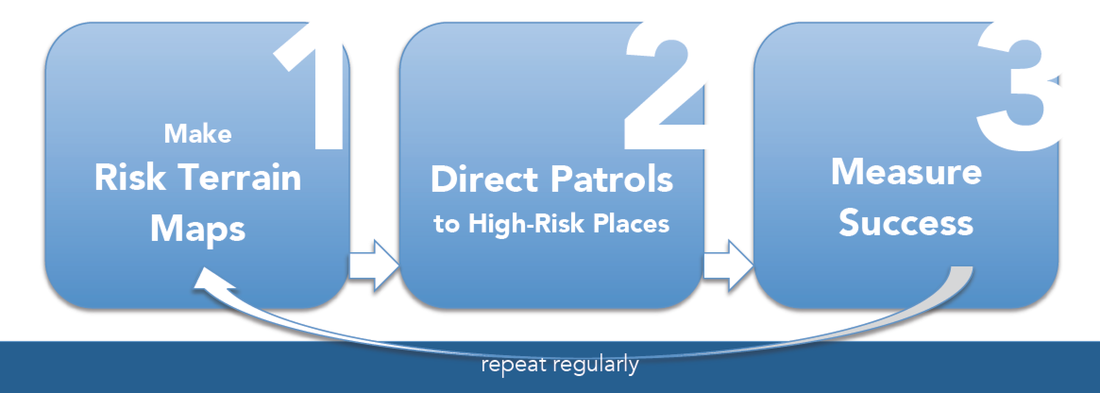When crime goes down or stays low, how do police know it’s what they did that made the difference?
One way to determine the impact of law enforcement and policing actions at high-risk places is to decide on the response strategy in advance of implementation, intentionally focusing policing actions on one (or more) of the risk factors. Specifically state this intent from the get-go. The factors that could be focused on will be identified by the risk terrain model. Then compare new risk terrain models to the older ones.
For example, if "convenience stores" were a top risk factor for motor vehicle thefts, a risk reduction strategy might be to increase patrols around convenience stores located in high-risk areas; to put sign-in sheets in the stores for officers to engage more with the managers while showing a police presence; or to display informational posters on store windows reminding customers: "Turn off car. Take keys. Lock doors. Prevent theft." There are more and probably better examples than this. But hopefully you get the idea.
Then, after deploying that risk reduction strategy for a period of time (e.g., 1 month), run a new risk terrain model and compare the Relative Risk Value (RRV) of the before-and-after results for the targeted risk factor. If the factor that you intentionally focused on has a lower RRV after the intervention compared to what it had before your intervention activities, then you may have had an effect. If crime also went down during the intervention time period, then you may have prevented crimes by mitigating the risk factor. Both of these things -- risk reduction and crime prevention -- could be credited to the police activities. If the risk factor (e.g., convenience stores) was present in the risk terrain model before the intervention and wasn't present in the model after the intervention, then that could mean you completely mitigated the risk factor's spatial influence based on your actions. It's no longer a crime attractor/generator. Now you can deal with any new crime dynamics that exist, which you know well based on the newly updated risk terrain model that serves as your next month's forecast and intel for risk reduction strategies and deployments.
One way to determine the impact of law enforcement and policing actions at high-risk places is to decide on the response strategy in advance of implementation, intentionally focusing policing actions on one (or more) of the risk factors. Specifically state this intent from the get-go. The factors that could be focused on will be identified by the risk terrain model. Then compare new risk terrain models to the older ones.
For example, if "convenience stores" were a top risk factor for motor vehicle thefts, a risk reduction strategy might be to increase patrols around convenience stores located in high-risk areas; to put sign-in sheets in the stores for officers to engage more with the managers while showing a police presence; or to display informational posters on store windows reminding customers: "Turn off car. Take keys. Lock doors. Prevent theft." There are more and probably better examples than this. But hopefully you get the idea.
Then, after deploying that risk reduction strategy for a period of time (e.g., 1 month), run a new risk terrain model and compare the Relative Risk Value (RRV) of the before-and-after results for the targeted risk factor. If the factor that you intentionally focused on has a lower RRV after the intervention compared to what it had before your intervention activities, then you may have had an effect. If crime also went down during the intervention time period, then you may have prevented crimes by mitigating the risk factor. Both of these things -- risk reduction and crime prevention -- could be credited to the police activities. If the risk factor (e.g., convenience stores) was present in the risk terrain model before the intervention and wasn't present in the model after the intervention, then that could mean you completely mitigated the risk factor's spatial influence based on your actions. It's no longer a crime attractor/generator. Now you can deal with any new crime dynamics that exist, which you know well based on the newly updated risk terrain model that serves as your next month's forecast and intel for risk reduction strategies and deployments.

